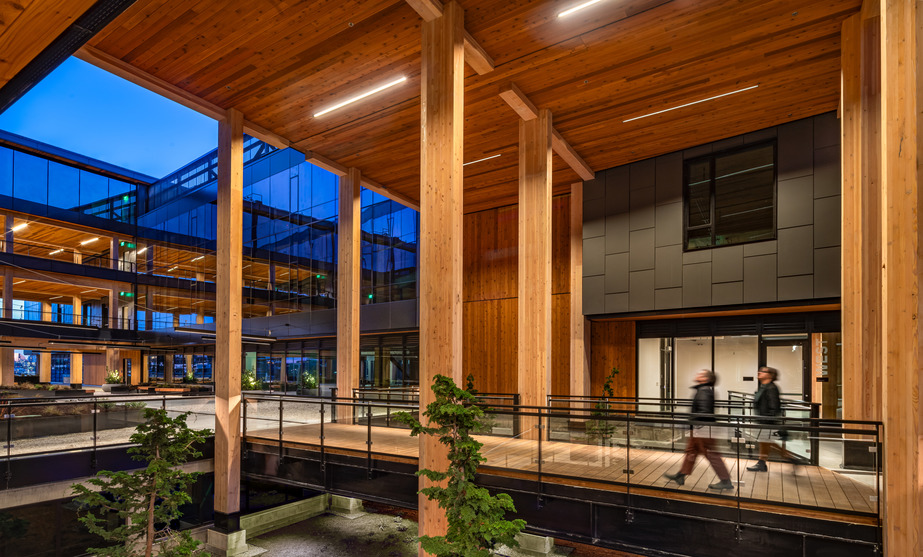By Lindsey Coulter
As mass timber use continues to proliferate across building sectors in the U.S. and globally, U.S. senators from both sides of the political aisle have joined forces to promote the sustainable, biophilic natural resource. On March 25, Sen. Jeff Merkley of Oregon and Sen. James Risch of Idaho announced a bipartisan effort to promote mass timber use in federal building projects and military construction, paving the way for even more widespread adoption of materials such as cross-laminated timber, mass plywood panels and other popular mass-timber products.
The bipartisan Mass Timber Federal Buildings Act—cosponsored by Senators Ron Wyden of Oregon and Mike Crapo of Idaho—would incentivize the use of mass timber building materials by providing a preference in federal building contracts for mass timber products. It would also give mass timber companies the ability to compete for federal construction, renovation, or acquisition of public buildings and for military construction. The announcement of the act also coincided with the start of the International Mass Timber Conference—the world’s largest gathering of mass timber experts—taking place this week in Portland, Ore.
“Mass timber creates jobs in rural and urban communities, reduces wildfire risk, increases forest resiliency and helps us shrink our carbon footprint,” said Merkley in a statement. “This expanding industry presents a huge opportunity for Oregon, and we must do all we can to harness its power for our economy and environment. By using mass timber in federal projects, our bipartisan effort around this critical industry will help tackle our nation’s biggest challenges while creating good-paying jobs in Oregon and across the Pacific Northwest.”
Risch, who is a trained forester, noted the importance of his state’s timber industry, connecting the proposed legislation to wildfire risk reduction and responsible forest management.
“The Mass Timber Federal Buildings Act is commonsense legislation to benefit Idaho’s forests, create jobs and increase economic growth,” Risch said.
Wyden also pointed to mass timber’s potential to generate jobs, reduce carbon emissions, and build an innovative approach to combat the shortage of housing nationwide, while Crapo noted that “boosting demand for Idaho timber in the construction of federal buildings will harness the incredible work already done in our forests, and create new opportunities for Idaho companies, workers and products.”
The bipartisan bill proposes a two-tier contracting preference for mass timber and other innovative wood-based projects. The first-tier preference applies to mass timber that is made within the U.S. and responsibly sourced from state, federal, private and Tribal forestlands, while the optional second tier applies to mass timber products that are sourced from restoration practices, fire mitigation projects and/or underserved forest owners. Additionally, the bill includes a reporting requirement for a whole-building lifecycle assessment. The results of the assessment would provide additional evidence of the carbon-sequestration benefits of mass-timber buildings.
Lawmakers have garnered broad industry support for the legislation, even among landowners. In addition to backing from industry groups such as the American Wood Council, Sustainable Northwest and the Oregon Forest Industries Council, the Mass Timber Federal Buildings Act is also endorsed by the Forest Landowners Association and the National Alliance of Forest Owners (NAFO).
Dave Tenny, president and CEO of NAFO, noted the abundance and sustainable nature of wood, while also noting the value of using American-grown wood to bolster the nation’s private working forests and the rural communities that depend on them.
“As global leaders in modern, sustainable forest management, U.S. forest owners are already growing the wood needed to expand mass timber construction,” Tenny said in a statement. “Because of the strong relationship between forest products markets and sustainable forest management, today we have 60% more wood in our forests than we had in the 1950s. This positions mass timber construction to deliver wins for the economies of rural communities, our nation’s water quality, wildlife and more.”
Other industry leaders have touted the legislation and general investments in mass timber for expanding new markets for wood products, supporting domestic manufacturing, supporting active forest management, reducing wildfire risk, and creating jobs in forestry, manufacturing and construction.
“The State of Washington is poised to supply high-quality mass-timber products to public buildings across the United States, sourced from federal forest restoration projects and forests cared for and managed by Tribal Nations, contributing to wildfire risk reduction and rural community economic development,” said Erica Spiritos, director of the Washington Mass Timber Accelerator, in a statement. “These mass timber buildings can be built with labor standards and apprenticeship opportunities, and will endure long into the future, and serve as a celebration and reminder of our commitment to people and planet.”


